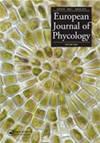Geography and climate drive the distribution and diversification of the cosmopolitan cyanobacterium Microcoleus (Oscillatoriales, Cyanobacteria)
IF 1.7
4区 生物学
Q2 MARINE & FRESHWATER BIOLOGY
引用次数: 4
Abstract
ABSTRACT Despite the extensive diversity of bacteria and their importance to the fundamental functioning of terrestrial ecosystems, their distribution patterns are still not fully known. To fill the gap and further understand the biogeographic patterns in bacteria, we investigated the phylogeographic structure and the underlying drivers of diversification among populations of the cyanobacterium Microcoleus spp. The phylogenetic history was reconstructed using 16S rRNA genes and the 16S–23S internal transcribed spacer (ITS) of 495 Microcoleus spp. isolates. Ancestral area and state reconstruction was employed to investigate the distributional and ecological patterns within Microcoleus. Both isolation by distance and isolation by environment were tested with distance matrices analysis. The phylogenetic signal tests were conducted in order to assess the influence of the climatic preferences on the diversification of Microcoleus isolates. The distribution and phylogenetic diversification of Microcoleus are driven by both isolation by distance and environment, leading to at least 13 distinct lineages that could represent novel cyanobacterial species. Microcoleus spp. exhibited a distinct phylogeographic structure within the respective lineages. The ancestral area and state reconstruction revealed that Microcoleus most likely arose in Europe in terrestrial habitats. The phylogenetic signal showed that the phylogeny significantly affects the climatic preferences of Microcoleus strains. Geographic distance and contemporary climatic conditions play significant roles in shaping the distribution and diversification of Microcoleus. The observed patterns of distribution may shift in the future due to the impact of climate change. Highlights Microcoleus exhibited distinct phylogeographic structure within the respective lineages. Geographic and environmental heterogeneity affect Microcoleus distribution and diversification. Genetically distinct lineages coexist at the same site.地理和气候驱动着世界性微小蓝细菌的分布和多样化
摘要尽管细菌种类繁多,对陆地生态系统的基本功能也很重要,但它们的分布模式仍不完全清楚。为了填补这一空白并进一步了解细菌的生物地理学模式,我们研究了微亮蓝细菌种群多样性的系统地理学结构和潜在驱动因素。使用495个微亮蓝菌分离株的16S rRNA基因和16S–23S内转录间隔区(ITS)重建了系统发育史。采用祖先区域和国家重建的方法来调查Microcleus的分布和生态模式。采用距离矩阵分析法对距离隔离和环境隔离进行了测试。进行系统发育信号测试,以评估气候偏好对Microcleus分离株多样化的影响。Microcleus的分布和系统发育多样化是由距离和环境的隔离驱动的,导致至少13个不同的谱系可以代表新的蓝藻物种。Microcleus spp.在各自的谱系中表现出独特的系统地理结构。祖先地区和国家重建表明,Microcleus最有可能出现在欧洲的陆地栖息地。系统发育信号表明,系统发育显著影响Microcleus菌株的气候偏好。地理距离和当代气候条件对微球菌的分布和多样化起着重要作用。由于气候变化的影响,观测到的分布模式可能在未来发生变化。亮点Microcleus在各自的谱系中表现出独特的系统地理学结构。地理和环境的异质性影响微细胞的分布和多样化。基因上不同的谱系共存于同一地点。
本文章由计算机程序翻译,如有差异,请以英文原文为准。
求助全文
约1分钟内获得全文
求助全文
来源期刊

European Journal of Phycology
生物-海洋与淡水生物学
CiteScore
4.80
自引率
4.20%
发文量
37
审稿时长
>12 weeks
期刊介绍:
The European Journal of Phycology is an important focus for the activities of algal researchers all over the world. The Editors-in-Chief are assisted by an international team of Associate Editors who are experts in the following fields: macroalgal ecology, microalgal ecology, physiology and biochemistry, cell biology, molecular biology, macroalgal and microalgal systematics, applied phycology and biotechnology. The European Journal of Phycology publishes papers on all aspects of algae, including cyanobacteria. Articles may be in the form of primary research papers and reviews of topical subjects.
The journal publishes high quality research and is well cited, with a consistently good Impact Factor.
 求助内容:
求助内容: 应助结果提醒方式:
应助结果提醒方式:


